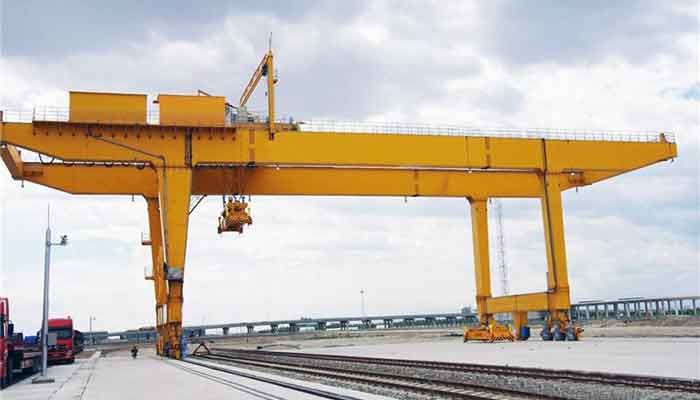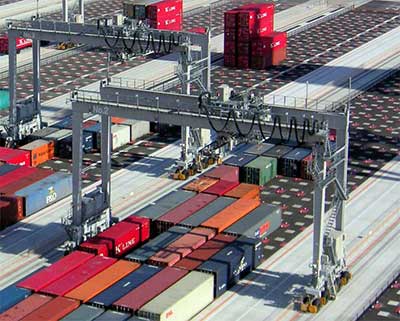Research on the Standardization of Rail Mounted Gantry Crane Specifications -Ⅱ
It the last blog, we have discussed the standardization of rail mounted gantry crane specifications from the aspect of rail distance and extended distance, in this blog, we will continue this topic, but from the aspect of motion specifications and recommended specifications.

Study on the standardization of rail mounted gantry (RMG) crane motion specifications
Research on the motion specifications of rail mounted gantry crane from the aspect of loading and unloading
From the point of loading and unloading to research on the motion specifications of rail mounted gantry crane, main factors that affect the working efficiency includes:
Rated lifting weight and number of working cycles per hour. The rated lifting weight has been determined by the objective factor of the yard, but the number of working cycles per hour is mainly related to the lifting speed and the running speed of the RTG crane. At present, the maximum lifting speed of rail mounted gantry crane can reach 40m/min, and the running speed of the trolley is up to 120m/min.
Operation cycle of rail mounted gantry crane is: Lifting trolley - trolley operation - heavy load trolley - no-load trolley - trolley operation - no load drop. Operating time T that complete a operation cycle is inversely proportional to the lifting speed and running speed of trolley. That is to say, the higher the lifting speed and running speed of the trolley, the higher the efficiency of loading and unloading.
Through the calculation of the working cycle time of several different specifications of the rail mounted gantry crane, it is found that when the lifting speed is less than 30m/min, the change of lifting speed has great influence on the completion of a work cycle. When the lifting speed is greater than 80m/min, the running speed of the trolley is greater than 130m/min, the change of speed is not obvious to the operation time T of the completion of a work cycle. Thus the selection of lifting speed should be controlled in the range of 30~80m/min, the trolley running speed should be controlled in the range of 60~130m/min.
Research on the motion specifications of rail mounted gantry crane from the aspect of energy consumption

Through test the energy consumption situation of rail mounted gantry crane, the effects of lifting speed, trolley running speed, and running speed change of running bridge on the energy consumption were studied, it shows that: when the lifting speed is greater than 20m/min, the increase of speed has little effect on the energy consumption; when the running speed of trolley is greater than 40m/min, the increase of speed has little effect on the energy consumption. Therefore, it is recommended to choose the lifting speed greater than 20m/min as far as possible, running speed of the trolley is maintained above 40m/min, which will not only reduce energy consumption, but also improve the efficiency of loading and unloading.
The smaller the running speed of running bridge, the larger the energy consumption, what’s more, when the running bridge is running at low speed, the energy consumption increases greatly. When the speed of running bridge is greater than 20m/min, the increase of speed has little effect on the energy consumption. Therefore, the speed of running bridge should be greater than 20m/min, no-load running speed of rail mounted gantry crane can be increased appropriately.
Known from the analysis, lifting speed, running speed of the trolley, running speed of the running bridge is inversely proportional to the energy consumption, that is, the faster the speed is, the smaller the energy consumption is, the more close to the rated value, the less power loss, the lower the energy consumption. During the whole working cycle, the energy consumption of the lifting process is the largest, and the trolley running process is small. Thus during the running process, there are a little differences between using rail mounted gantry crane with small span and that with large span.
Calculate the lifting speed according to the actual power of motor
During operation, the actual lifting speed is determined by the power of selected motor, which may be slightly different with the rated value that the design requires. In this research of rail mounted gantry crane specifications, the actual speed is calculated according to the power of motor, so that the lifting speed series is closer to the actual value.
According to the design specifications of rail mounted gantry crane and the calculation of the motor power, the actual lifting speed is shown in Table 1.
| Power of Motor / kw | G=30.5t | G=35t | G=40t |
|---|---|---|---|
| 37 | 5.2 | 4.7 | 4.2 |
| 45 | 6.3 | 5.7 | 5.1 |
| 55 | 7.7 | 7.0 | 6.3 |
| 75 | 10.6 | 9.5 | 8.6 |
| 90 | 12.7 | 11.4 | 10.3 |
| 110 | 15.5 | 13.9 | 12.5 |
| 132 | 18.6 | 16.7 | 15.0 |
| 160 | 22.5 | 20.3 | 18.2 |
| 200 | 28.1 | 25.3 | 22.8 |
| 220 | 31.0 | 27.9 | 25.1 |
| 250 | 35.2 | 31.7 | 28.5 |
| 315 | 44.3 | 39.9 | 35.9 |
| 355 | 50.0 | 45.0 | 40.5 |
| Note: the sling weight is 10t, the loading efficiency is calculated by 95% | |||
According to the above table, the lifting speed sequence can be recommended: 5, 10, 15, 18, 22, 25, 28, 35, 40, 45, 50.
Recommended Specifications Series of Rail Mounted Gantry Crane
The larger the rail distance of rail mounted gantry crane, the higher the rate of container transposition, so that the lower the efficiency of loading and unloading. The larger the extended distance, in order to meet the requirements of strength and stiffness, the larger the section of rail mounted gantry crane, the whole crane is heavy, and the manufacture cost is high. The closer the lifting speed, running speed of trolley, and running speed of sunning bridge are to the rated speed, the better the energy saving, and the higher the efficiency of loading and unloading. But if the rated speed is too high, the actual use can not reach to the rated speed, it will cause a waste of energy, therefore, the choice of the speed of the mechanism should be within a reasonable range, and the actual loading and unloading operations should try to run as far as possible at the rated speed. Therefore, combined with the specifications of the existing rail mounted gantry crane, the specifications sequence of rail mounted gantry crane is obtained in Table 2.
| Items | Specification Series |
|---|---|
| Rail Distance | (15),(18),(20),(23.5),26,30,32,35,37,40,(43),46,(49),51,(54),(57),60,(62) |
| Extended Distance | 3,5,7,9,(10.5),(12),(14.5) |
| Lifting Speed | (10),15,20,22,25,28,35,40 |
| Running Speed of Trolley | (40),50,60,70,80,90,100,110,120,(130),(140) |
| Running Speed of Running Bridge | Full Load: 20,30,35,40,50,60,70 No Load: 60,70,80,90,100,110,120,(130),(140),(150) |
| Note: values in the brackets are not recommended. | |
Conclusion on the standardization of rail mounted gantry crane specifications
The lifting height of rail mounted gantry crane is determined by the stacking layer, the running speed of each mechanism is also determined flexibly by the actual situation of every port, the harbour can be a bit higher, and the inland port can be lower. Therefore, the lifting height, lifting speed, running speed and the speed of the cart running speed parameter values do not need to do mandatory, the rail mounted gantry crane specifications can be determined according to the actual situation, the specific value can refer to table 4. In terms of developing trend and process of loading and unloading, it is recommended to set extended distance , the outside of the cantilever is only arranged in the driveway and no pile box, the recommended value of extended distance are 3.5m and 7m. As the most important specifications of rail mounted gantry crane, the standardization of rail distance has little significance on the standard of rail mounted gantry crane design, application, and the process of port layout. Combined with domestic and international research situation, recommended values for standard rail distance of rail mounted gantry crane are 32m, 35m, 37m, 40m.



